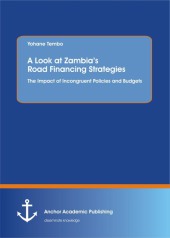 Neuerscheinungen 2015Stand: 2020-02-01 |
Schnellsuche
ISBN/Stichwort/Autor
|
Herderstraße 10
10625 Berlin
Tel.: 030 315 714 16
Fax 030 315 714 14
info@buchspektrum.de |

Yohane Tembo
A Look at Zambia´s Road Financing Strategies: The Impact of Incongruent Policies and Budgets
Erstauflage. 2015. 124 S. 220 mm
Verlag/Jahr: ANCHOR ACADEMIC PUBLISHING 2015
ISBN: 3-9548935-1-7 (3954893517)
Neue ISBN: 978-3-9548935-1-5 (9783954893515)
Preis und Lieferzeit: Bitte klicken
There are various reasons why the road asset in Zambia has been deteriorating over the past five decades since independence. Much effort to restore the road asset to its original value and keep it maintained in a good and safe condition was initiated in mid 1990s with the launch of the Road Sector Investment Plan Phase I, which was immediately followed by the launch of a Phase II to run from 2003 to 2013. It is my appreciation that many diagnostic studies into road financing strategies which could have led to inefficient road asset management in Zambia have been undertaken, and various solutions tendered.
The author takes cognizance that resource mobilization for road construction and maintenance, and subsequent allocation to respective road programs can often be problematic for an emerging country like Zambia. It has the potential to lead to inefficiencies in road asset management as has evidently been demonstrated in the declining road asset value over time. The political, as well as the economic, landscape plays a vital role in resource mobilization and allocation strategies as much as the institutional and the legal framework do.
The failure to clear the backlog of maintenance which normally results, largely, from deferment of scheduled maintenance due to insufficient annual budgetary allocation to the road sector maintenance programs has led to the significant deterioration in road network condition. Exorbitant road construction costs have posed additional challenges to the fiscus, thereby constraining both the quantity and quality of road infrastructure that could be constructed and maintained at any given time. Recent policy drives have been categorical in their preference of new road construction aimed at linking Zambia, over road maintenance, which plays a pivotal role in road asset management.
This creates a perception that policy pronouncements are at variance to policy documents which promote sustainable economic development through efficient road investments and could be seen as being paradoxical in that the actual financing strategies are skewed towards road construction, a recipe of comfort for the next election challenge due to increased visibility on the ground, rather than to maintenance, as an astute and effective way of managing the road asset.
The difficult of establishing congruence between government pronouncements and actual road business strategies in the implementing agencies has, over the years, posed challenges to the fiscal policy implementation. Consequently, this has often led to serious budget overruns due, firstly, to unplanned expenditure and, secondly, variations due to scope increase resulting from project implementation without having prior designs. This has led to high operating inefficiencies of existing roads due to the high level of pavement degradation, with the eventual effect of higher vehicle operating costs, longer travel-times, driver and passenger discomfort, and ultimately, higher agency pavement replacement costs. The damage caused to the economy is apparent in all this.
The author carried out an analysis of road financing strategies in Zambia, taking a special look into the past decade, with the view to ascertaining the extent to which roads budgets have been employed to fund new construction and maintenance. This was necessary to establish whether there was a mismatch in allocation of resources for roads in terms of needs and policy, in which new road construction is highly favored in preference to maintenance. It was hoped that if the mismatch existed, it would espouse some paradoxes which existed between the road asset management policies and actual strategies.
The research draws attention to the fact that over 80% of the Core Road Network is in poor condition, and only 68% of the paved Trunk, Main, and District road network could be said to be in good condition. Further investigations revealed that the country has been spending an average of 0.71% of its Gros


